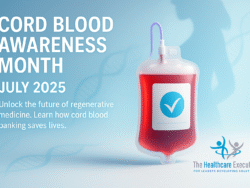National Infant Immunization Week

- Posted by Greg Wahlstrom, MBA, HCM
- Posted in Health Observance Calendar
Executive Leadership in Vaccine Equity and Early Prevention
Published: April 22, 2025
National Infant Immunization Week (NIIW), observed April 22–29, 2025, highlights the critical importance of protecting infants from vaccine-preventable diseases. Coordinated by the Centers for Disease Control and Prevention (CDC), this observance provides healthcare leaders with an opportunity to elevate early prevention strategies and address vaccine access gaps within their systems. Hospital executives must see NIIW not only as a public health reminder but also as a strategic moment to assess pediatric vaccination rates, partnerships with community providers, and alignment with state immunization registries. Health systems such as Golisano Children’s Hospital have embedded immunization advocacy into their newborn care pathways, helping reduce disparities and improve early childhood outcomes. Immunization access is foundational to health equity, and leaders must ask whether their organization is reaching every child in every ZIP code. Coordinated immunization efforts not only save lives—they prevent future surges in costly, preventable illnesses. Executives who treat NIIW as a performance checkpoint for population health will advance both mission and margin. In today’s climate of misinformation and declining trust, proactive leadership is essential.
Hospital boards should use National Infant Immunization Week to evaluate organizational infrastructure supporting timely vaccination. Electronic health records should include robust vaccine reminder systems, default scheduling templates for well-child visits, and automated reporting to state immunization information systems (IIS). Pediatric primary care clinics must be adequately staffed and supported to meet high standards for vaccine safety, documentation, and parent education. Leading health systems like Children’s National Hospital have integrated community-based vaccination programs with mobile units, multilingual outreach, and cross-system collaborations. Executive teams can explore how their own workforce wellness programs and maternal care services can amplify early childhood immunization awareness. Internal data reports should track vaccination delays, opt-outs, disparities by demographic group, and health literacy factors. NIIW is also a powerful opportunity for public relations teams to share success stories from front-line pediatric teams and immunization nurses. Board briefings this week should include updates on measles resurgence risks, vaccine coverage benchmarks, and new recommendations from ACIP. A hospital’s immunization posture is a reflection of its operational integrity, equity mission, and clinical excellence. Strong leadership ensures those values align.
Equity in immunization delivery must be a strategic priority for executive leadership during NIIW. National data shows that infants in lower-income, rural, and historically marginalized communities are more likely to experience vaccine delays or incomplete series. According to the National Library of Medicine, vaccine hesitancy and access barriers intersect with systemic inequities in education, housing, and transportation. Hospitals like Children’s Hospital of Philadelphia have launched Vaccine Education Centers and culturally responsive campaigns to address those gaps head-on. Executives must allocate resources to support these efforts—not as outreach extras, but as core equity interventions. Outreach plans should include partnerships with WIC offices, early intervention programs, federally qualified health centers (FQHCs), and local school readiness organizations. Community health workers, especially those with lived experience, should be employed and trusted to lead vaccine education and navigation efforts. These partnerships must be embedded in strategic operating plans and tied to measurable goals. NIIW gives hospital leaders a unique platform to elevate trust, transparency, and vaccine confidence through systemic action. Equity isn’t achieved through slogans—it requires infrastructure and follow-through.
Technology and digital transformation also play a critical role in advancing immunization delivery. Executives should ensure that their health system’s digital tools—especially patient portals, appointment systems, and EHR interfaces—support vaccine outreach and follow-up. At Ochsner Health, leaders have piloted automated pediatric reminders and embedded health literacy resources into mobile apps, improving follow-up for critical immunizations. Strategic investments in AI-assisted risk profiling and social needs screening can help flag patients most at risk for missed doses. These innovations should be governed with strict attention to data security, parental consent, and digital equity. Hospital CIOs and CMOs should be aligned in using NIIW to review the interoperability of their immunization tracking systems with local public health departments and state registries. Digital health is not a future concept—it’s a present tool in the immunization toolbox. Board members should understand how digital solutions are enabling—or hindering—infant vaccine adherence. Executive stewardship ensures that innovation drives equity, not exclusion. And that begins with leadership owning both the opportunity and the obligation.
As National Infant Immunization Week comes to a close, healthcare executives must remain vigilant and proactive in their leadership. Immunization is foundational to health, and the first year of life is a critical window for protection. System-wide performance depends on how early we engage, how equitably we deliver, and how effectively we communicate. Communications teams should align messaging across clinical, social media, and community channels to reinforce vaccine safety and trust. Pediatric leadership should be empowered to shape operational workflows and report outcomes to the C-suite. Community leaders should be engaged to co-design culturally relevant education. Hospital boards should ask tough questions this week about reach, gaps, and measurable results. NIIW is not just a CDC observance—it’s a leadership challenge and a public responsibility. In the hands of visionary executives, immunization strategy becomes population health in action. And in the lives of our youngest patients, it becomes the first gift of lifelong protection.
Discover More
Explore how hospital executives can lead through prevention, pediatric equity, and public trust strategies.



